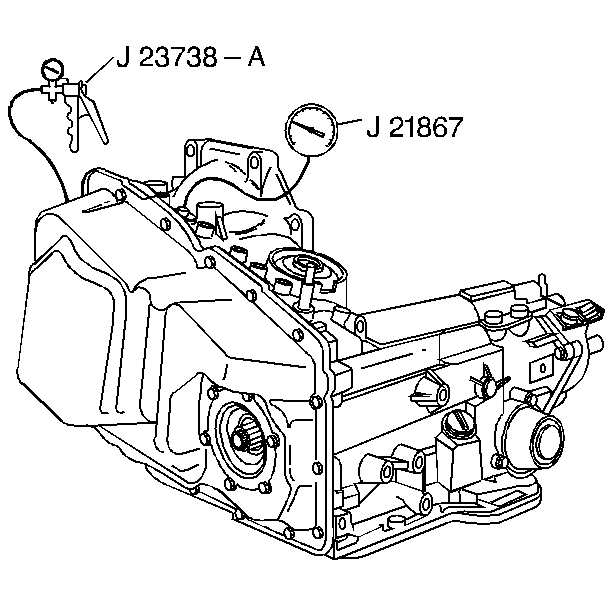
- Check the fluid. Refer to
Transmission Fluid Check
- Remove the line pressure plug and install J 21867
Pressure Gage (A).
- Disconnect the vacuum line from the transaxle modulator and connect J 23738-A
Vacuum Gage/Pump (B)
to the engine vacuum line.
Caution: Keep the brakes applied at all times in order to prevent unexpected
vehicle motion. Personal injury may result if the vehicle moves unexpectedly.
Notice: The total test running time should not be longer than 2 minutes.
Running the test longer than 2 minutes may damage the transaxle.
- Start the engine and set the parking brake.
- Note the vacuum pump gage:
| • | At sea level, the engine vacuum should be at least 61 kPa
(18 in Hg). |
| • | Engine vacuum will drop about 3.5 kPa (1 in Hg)
for every increase in altitude of 305 m (1000 ft). |
| • | If the engine vacuum is low, refer to Section 6A/6E
for diagnosis. |
- Disconnect J 23738-A
vacuum gage/pump (B) from the engine vacuum line. Connect J 23738-A
vacuum gage/pump (B) to the transaxle
modulator. Install a plug in the engine vacuum line to prevent a vacuum leak.
- Raise the engine speed to 1250 RPM.
- Check the transaxle line pressure:
| • | Minimum Line Pressure-provide 61 kPa (18 in Hg)
of vacuum to the modulator with J 23738-A
gage/pump (B). |
| • | Full Line Pressure-provide 0 kPa (0 in Hg)
of vacuum to the modulator with J 23738-A
gage/pump (B). |
| • | Note the pressure readings in all gear ranges for both Minimum
and Full Line Pressure. Compare these readings with the information in the
Line Pressure
. |
- Use the
High or Low Oil Pressure
Condition Diagnosis Charts to diagnose the line pressure
readings that are too low or too high.
- Reconnect the engine vacuum line to the transaxle modulator. Remove J 21867
pressure gage (A) with
the engine off. Install the line pressure plug.

